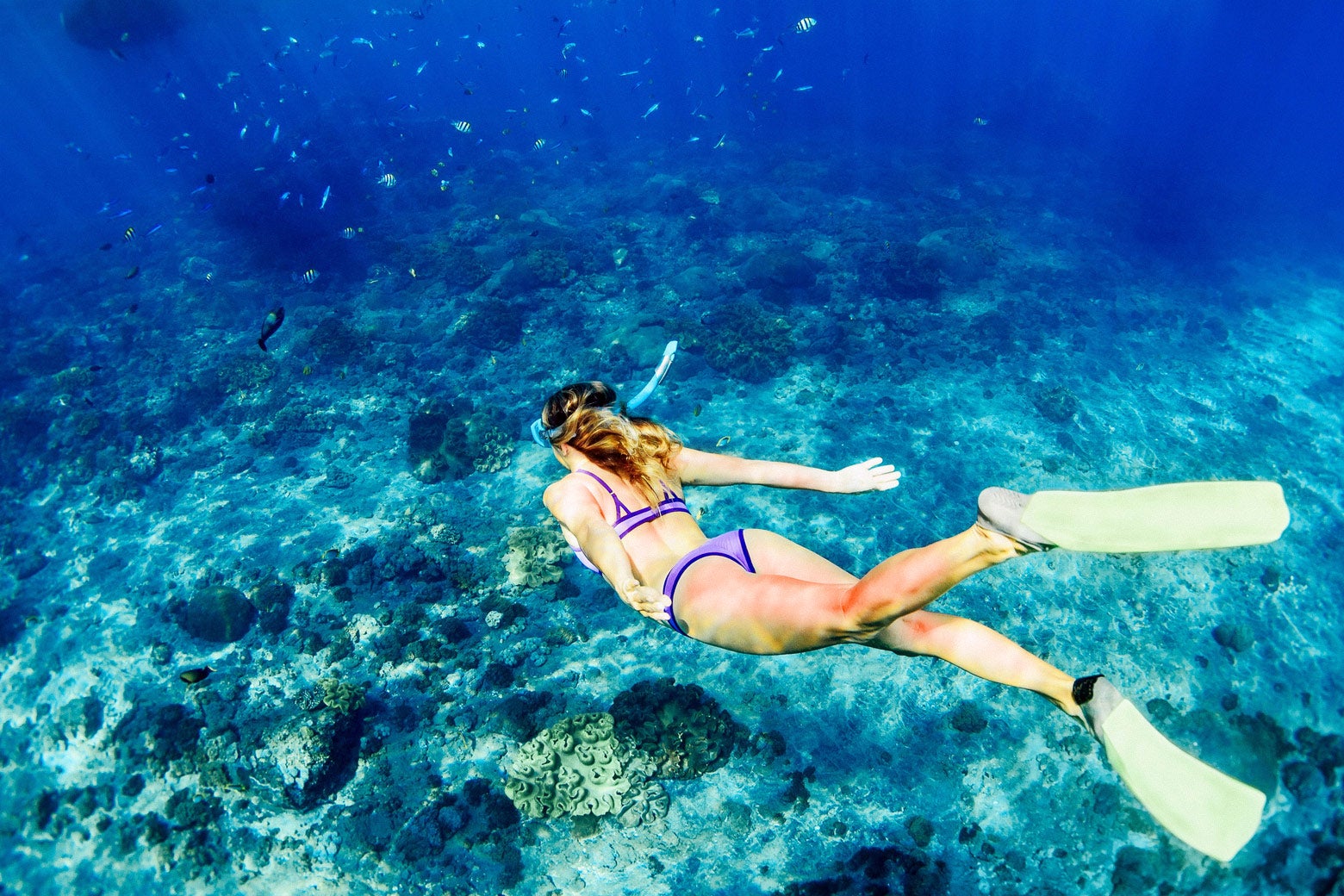For years, we were told to apply sunscreen, and apply it liberally. Whether lying on the sand or snorkeling among the waves, slathering up seemed almost a moral obligation—the slimy, shiny price of enjoying the sun. The risks of skin cancer were absorbed into our psyches as deeply as we once absorbed UV rays—SPF 50 or go home. With the invention of waterproof sunscreen in 1977 and the rise of sun-safety awareness, the chemical-y smell of sunscreen became an unmissable feature of the beach vacation.
But since research now suggests that oxybenzone and octinoxate, which show up in almost all major sunscreens, are harmful to the marine ecosystem, we seem to have a moral dilemma on our sunscreen-coated hands: ruin your skin, or ruin the environment. In a 2015 study, oxybenzone and octinoxate were found to contribute to coral bleaching (the scourge that has more or less destroyed the Great Barrier Reef), slow new coral growth, and disrupt marine life. The study found the chemicals in especially high concentrations in popular tourist waters, especially in Hawaii and the U.S. Virgin Islands. In response, some resorts and tour companies have chosen to ban or educate against nonbiodegradable sunscreens, while the National Park Service recommends being “reef friendly” by choosing sunscreens made with natural mineral ingredients such as titanium oxide or zinc oxide.
Now Hawaii, seemingly unwilling to go down the same path as the Great Barrier Reef, has become the first state to ban the sale of sunscreen containing the coral-killing chemicals. The legislation, which still awaits the governor’s signature, won’t come into effect until 2021, giving sunscreen producers plenty of time to switch over to a safer formula. Hawaii’s ban leaves producers with two options: continue offering chemical sunscreens without oxybenzone and octinoxate or switch over to natural, mineral-based sunblocks.
Producers, however, have seemed unwilling to adapt thus far—in fact, they opposed Hawaii’s legislative efforts. Trade groups representing the cosmetics and over-the-counter-medicines industries—the Personal Care Products Council and the Consumer Healthcare Products Association—have pointed to the other, “real” causes of coral bleaching, scapegoating “global warming, agricultural runoff, sewage and overfishing” for the decline of coral. (One researcher behind the 2015 study, meanwhile, told the New York Times that the effect of the chemicals on coral is “bigger than climate change.”) The Personal Care Products Council has continued to insist that oxybenzone is key to preventing skin cancer; the Consumer Healthcare Products Association went as far as to say that Hawaii’s ban of it compromises “health, safety and welfare” of residents and tourists. In other words, they’re pouring money into lobbying and campaigning rather than developing safer products.
In refusing to tackle this ecological issue head-on, major sunscreen brands have put the onus on environmentally conscious consumers (and resorts) to seek out atypical reef-friendly options. Some companies do offer one or two oxybenzone-free options among their range, but these products still make up the minority of those on the market: The Consumer Healthcare Products Council, in attempting to criticize the new bill, puts this number at less than 30 percent, accusing the new Hawaiian law of banning “at least 70 percent of the sunscreens on the market today.” (Research is mixed on whether mineral-based sunscreens—known as “physical blockers” because they sit on top of the skin—are as effective as chemical-based ones. Some claim they are more effective, protecting against both UVA and UVB rays by deflecting rather than absorbing sun.)
But if we’re going to take environmental preservation seriously, the onus must be on producers, not consumers, to recognize and prevent the damage their products can do. It shouldn’t be on vacationers to choose between skin cancer and feeling responsible for the destruction of our natural wonders—and in any case, too many are unaware of the choice they are making. Hawaii is a start. Hopefully the ban will drive sunscreen producers to finally address this problem—that or stop selling in the Aloha State, which seems unlikely. In developing new products for the Hawaiian market, major brands like Hawaiian Tropic, Banana Boat, and Coppertone can and should apply their efforts to their global markets.
If producers won’t budge on their own, it will be up to legislatures to continue to force their hand with similar laws. My home country of Australia, with its global warming–deadened reef and unfortunate title of skin-cancer capital of the world, ought to introduce such a ban—with a sunscreen market supposedly worth an annual $289 million in U.S. currency, this too will force producers to change their ways. The destruction of the Great Barrier Reef, meanwhile, should be a lesson to other countries with marine-tourism industries. The skin care industry may have a financial incentive to continue using oxybenzone in its products until stopped, but countries have a financial disincentive to allow it: The Australian government has recently launched a $500 million package to try to save the reef, though it may not even work.
Just as governments are starting to place responsibility for preventing waste on producers, more accountability needs to be placed on chemical-heavy product producers, be that through fines for environmental damage or all-out bans. As the well-internalized Aussie sun-safety message goes, “Slip, Slop, Slap.” Or in this case, slip on a ban, slop on regulations, slap with fines.
